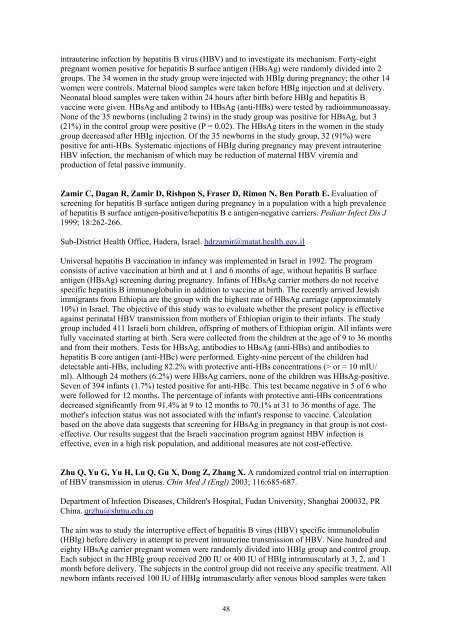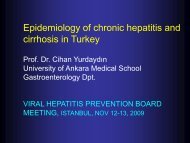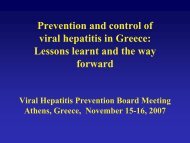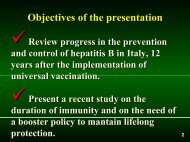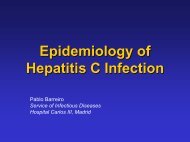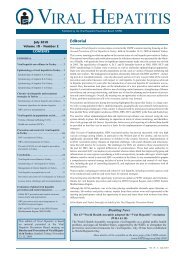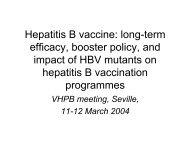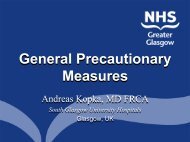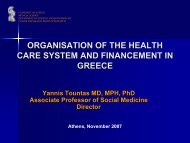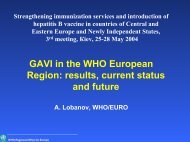Prevention and control of perinatal hepatitis B virus transmission in ...
Prevention and control of perinatal hepatitis B virus transmission in ...
Prevention and control of perinatal hepatitis B virus transmission in ...
You also want an ePaper? Increase the reach of your titles
YUMPU automatically turns print PDFs into web optimized ePapers that Google loves.
<strong>in</strong>trauter<strong>in</strong>e <strong>in</strong>fection by <strong>hepatitis</strong> B <strong>virus</strong> (HBV) <strong>and</strong> to <strong>in</strong>vestigate its mechanism. Forty-eightpregnant women positive for <strong>hepatitis</strong> B surface antigen (HBsAg) were r<strong>and</strong>omly divided <strong>in</strong>to 2groups. The 34 women <strong>in</strong> the study group were <strong>in</strong>jected with HBIg dur<strong>in</strong>g pregnancy; the other 14women were <strong>control</strong>s. Maternal blood samples were taken before HBIg <strong>in</strong>jection <strong>and</strong> at delivery.Neonatal blood samples were taken with<strong>in</strong> 24 hours after birth before HBIg <strong>and</strong> <strong>hepatitis</strong> Bvacc<strong>in</strong>e were given. HBsAg <strong>and</strong> antibody to HBsAg (anti-HBs) were tested by radioimmunoassay.None <strong>of</strong> the 35 newborns (<strong>in</strong>clud<strong>in</strong>g 2 tw<strong>in</strong>s) <strong>in</strong> the study group was positive for HBsAg, but 3(21%) <strong>in</strong> the <strong>control</strong> group were positive (P = 0.02). The HBsAg titers <strong>in</strong> the women <strong>in</strong> the studygroup decreased after HBIg <strong>in</strong>jection. Of the 35 newborns <strong>in</strong> the study group, 32 (91%) werepositive for anti-HBs. Systematic <strong>in</strong>jections <strong>of</strong> HBIg dur<strong>in</strong>g pregnancy may prevent <strong>in</strong>trauter<strong>in</strong>eHBV <strong>in</strong>fection, the mechanism <strong>of</strong> which may be reduction <strong>of</strong> maternal HBV viremia <strong>and</strong>production <strong>of</strong> fetal passive immunity.Zamir C, Dagan R, Zamir D, Rishpon S, Fraser D, Rimon N, Ben Porath E. Evaluation <strong>of</strong>screen<strong>in</strong>g for <strong>hepatitis</strong> B surface antigen dur<strong>in</strong>g pregnancy <strong>in</strong> a population with a high prevalence<strong>of</strong> <strong>hepatitis</strong> B surface antigen-positive/<strong>hepatitis</strong> B e antigen-negative carriers. Pediatr Infect Dis J1999; 18:262-266.Sub-District Health Office, Hadera, Israel. hdrzamir@matat.health.gov.ilUniversal <strong>hepatitis</strong> B vacc<strong>in</strong>ation <strong>in</strong> <strong>in</strong>fancy was implemented <strong>in</strong> Israel <strong>in</strong> 1992. The programconsists <strong>of</strong> active vacc<strong>in</strong>ation at birth <strong>and</strong> at 1 <strong>and</strong> 6 months <strong>of</strong> age, without <strong>hepatitis</strong> B surfaceantigen (HBsAg) screen<strong>in</strong>g dur<strong>in</strong>g pregnancy. Infants <strong>of</strong> HBsAg carrier mothers do not receivespecific <strong>hepatitis</strong> B immunoglobul<strong>in</strong> <strong>in</strong> addition to vacc<strong>in</strong>e at birth. The recently arrived Jewishimmigrants from Ethiopia are the group with the highest rate <strong>of</strong> HBsAg carriage (approximately10%) <strong>in</strong> Israel. The objective <strong>of</strong> this study was to evaluate whether the present policy is effectiveaga<strong>in</strong>st <strong>per<strong>in</strong>atal</strong> HBV <strong>transmission</strong> from mothers <strong>of</strong> Ethiopian orig<strong>in</strong> to their <strong>in</strong>fants. The studygroup <strong>in</strong>cluded 411 Israeli born children, <strong>of</strong>fspr<strong>in</strong>g <strong>of</strong> mothers <strong>of</strong> Ethiopian orig<strong>in</strong>. All <strong>in</strong>fants werefully vacc<strong>in</strong>ated start<strong>in</strong>g at birth. Sera were collected from the children at the age <strong>of</strong> 9 to 36 months<strong>and</strong> from their mothers. Tests for HBsAg, antibodies to HBsAg (anti-HBs) <strong>and</strong> antibodies to<strong>hepatitis</strong> B core antigen (anti-HBc) were performed. Eighty-n<strong>in</strong>e percent <strong>of</strong> the children haddetectable anti-HBs, <strong>in</strong>clud<strong>in</strong>g 82.2% with protective anti-HBs concentrations (> or = 10 mIU/ml). Although 24 mothers (6.2%) were HBsAg carriers, none <strong>of</strong> the children was HBsAg-positive.Seven <strong>of</strong> 394 <strong>in</strong>fants (1.7%) tested positive for anti-HBc. This test became negative <strong>in</strong> 5 <strong>of</strong> 6 whowere followed for 12 months. The percentage <strong>of</strong> <strong>in</strong>fants with protective anti-HBs concentrationsdecreased significantly from 91.4% at 9 to 12 months to 70.1% at 31 to 36 months <strong>of</strong> age. Themother's <strong>in</strong>fection status was not associated with the <strong>in</strong>fant's response to vacc<strong>in</strong>e. Calculationbased on the above data suggests that screen<strong>in</strong>g for HBsAg <strong>in</strong> pregnancy <strong>in</strong> that group is not costeffective.Our results suggest that the Israeli vacc<strong>in</strong>ation program aga<strong>in</strong>st HBV <strong>in</strong>fection iseffective, even <strong>in</strong> a high risk population, <strong>and</strong> additional measures are not cost-effective.Zhu Q, Yu G, Yu H, Lu Q, Gu X, Dong Z, Zhang X. A r<strong>and</strong>omized <strong>control</strong> trial on <strong>in</strong>terruption<strong>of</strong> HBV <strong>transmission</strong> <strong>in</strong> uterus. Ch<strong>in</strong> Med J (Engl) 2003; 116:685-687.Department <strong>of</strong> Infection Diseases, Children's Hospital, Fudan University, Shanghai 200032, PRCh<strong>in</strong>a. qrzhu@shmu.edu.cnThe aim was to study the <strong>in</strong>terruptive effect <strong>of</strong> <strong>hepatitis</strong> B <strong>virus</strong> (HBV) specific immunolobul<strong>in</strong>(HBIg) before delivery <strong>in</strong> attempt to prevent <strong>in</strong>trauter<strong>in</strong>e <strong>transmission</strong> <strong>of</strong> HBV. N<strong>in</strong>e hundred <strong>and</strong>eighty HBsAg carrier pregnant women were r<strong>and</strong>omly divided <strong>in</strong>to HBIg group <strong>and</strong> <strong>control</strong> group.Each subject <strong>in</strong> the HBIg group received 200 IU or 400 IU <strong>of</strong> HBIg <strong>in</strong>tramuscularly at 3, 2, <strong>and</strong> 1month before delivery. The subjects <strong>in</strong> the <strong>control</strong> group did not receive any specific treatment. Allnewborn <strong>in</strong>fants received 100 IU <strong>of</strong> HBIg <strong>in</strong>tramascularly after venous blood samples were taken48


